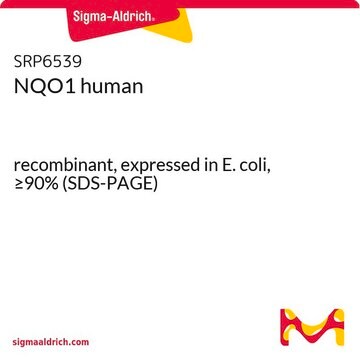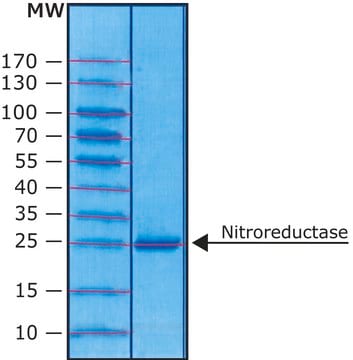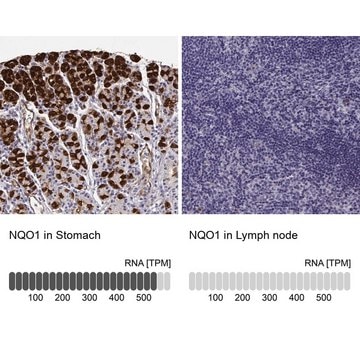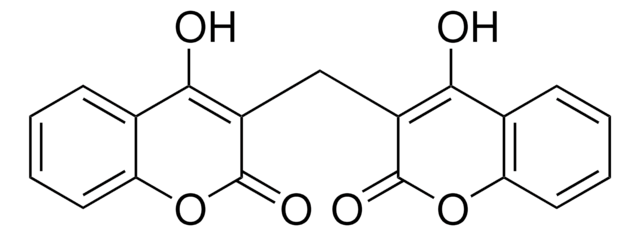Unfortunately, the solution stability of this product has not been determined. In such situations, preparing solutions fresh is recommended to assure optimum performance. However, various sources suggest that solutions of DT Diaphorase containing 10% glycerol and/or 0.1% BSA may be stable for several months when stored in aliquots at -20°C. This information has not been validated.
D1315
DT Diaphorase (NQO1) human
lyophilized powder, recombinant, expressed in E. coli, ≥90% (SDS-PAGE)
Synonym(s):
DTD, NQO1, Quinone reductase
Select a Size
About This Item
Recommended Products
recombinant
expressed in E. coli
Quality Level
Assay
≥90% (SDS-PAGE)
form
lyophilized powder
specific activity
≥100 units/mg protein
mol wt
monomer 31000
UniProt accession no.
storage temp.
2-8°C
Gene Information
human ... NQO1(1728)
Application
Biochem/physiol Actions
Unit Definition
inhibitor
Storage Class Code
11 - Combustible Solids
WGK
WGK 3
Flash Point(F)
Not applicable
Flash Point(C)
Not applicable
Personal Protective Equipment
Choose from one of the most recent versions:
Certificates of Analysis (COA)
Don't see the Right Version?
If you require a particular version, you can look up a specific certificate by the Lot or Batch number.
Already Own This Product?
Find documentation for the products that you have recently purchased in the Document Library.
Customers Also Viewed
-
Despite the recommended use of fresh solutions, can I store the NQO1 solution? What temperature and for low long?
1 answer-
Helpful?
-
-
Is it possible to obtain the concentration of α-Lactose monohydrate?
1 answer-
The specific composition of the product is proprietary, so we cannot disclose the concentration of α-Lactose monohydrate. However, the DT Diaphorase protein accounts for approximately 5% of the total solids in the vial.
Helpful?
-
-
What is the molecular weight of this product?
1 answer-
The product D1315 (DT Diaphorase (NQO1) human) is a monomer with a molecular weight of 30.87 KDa and has a homodimer structure.
Helpful?
-
-
What is the buffer composition of the lyophilized NQO1?
1 answer-
The lyophilized product D1315 is prepared in PBS buffer with α-Lactose monohydrate sourced from bovine milk.
Helpful?
-
-
본 제품인 DT-diaphorase (NQO1) human 의 수용해성 여부에 대한 정보가 없어 질문드립니다. 본 효소 제품이 수용해성을 가지고 있나요?
1 answer-
This product is soluble in water at 1 mg/ml. It is recommended that solutions be freshly prepared before each use.
Helpful?
-
-
I already received this enzyme (DT-Diaphorase) for my experiments. I would like to put in a buffer it is suitable in. Would you have any information on this matter? Thanks!
1 answer-
Product D1315 is lyophilized in PBS buffer with α-Lactose monohydrate. Since the powder already contains buffer and a stabilizer, it is recommended to use pure water. PBS is also an suitable option. It is recommended that the end-user does NOT try to weigh out a portion of the powder, because a representative sample may not be obtained. Please reconstitute the entire contents of the vial.
Helpful?
-
Active Filters
Our team of scientists has experience in all areas of research including Life Science, Material Science, Chemical Synthesis, Chromatography, Analytical and many others.
Contact Technical Service









